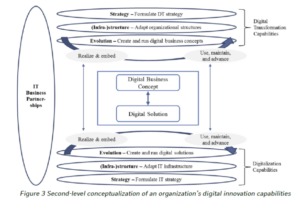Digital Innovation Capabilities
In our view both digital capabilities (digitalization capabilities and digital transformation capabilities) are represented by three symmetric dimensions: evolution, (infra-)structure, and strategy. The first dimension (evolution) concerns the evolution of digital innovations. Organizations need to be able to create and run digital solutions and digital business concepts, respectively. This involves a multi-step process (Fichman et al. 2014; Kohli and Melville 2018) including the identification, realization, and embedding, as well as the usage, maintenance and advancement of digital solutions and digital business concepts. Moreover, this refers to both the management of single digital innovation projects as well as the management of an organization’s entire digital innovation project portfolio. The second dimension ((infra-)structure) refers to the accompanying impact of digital innovations on IT infrastructures and organizational structures (such as governance, culture and so on). Organizations need to be able to adapt their structures accordingly in order to accommodate digital innovations (Chanias 2017; Hess and Barthel 2017; Wiesböck 2018). This also includes the adaptation of an organization’s human capital basis, the development of innovation promoting structures, and the initiation of the necessary cultural change (Hartl and Hess 2017; Hess and Barthel 2017; Hess et al. 2016; Piccinini et al. 2015). The third dimension (strategy) relates to the underlying IT and digital transformation strategies that capture the strategic impact of digital innovations. Organizations need to be able to formulate IT and digital transformation strategies and align them with other organizational strategies.
Following Wiesböck (2018), there is an additional transverse dimension that characterizes an organization’s DIC: the ability to foster IT business partnerships. Each of the different aspects related to an organization’s digitalization and digital transformation demands that organizations closely align the needs, requirements, perspectives, and work practices of their IT, business, and digital organizations and encourage cross-unit cooperation (Bharadwaj et al. 2013; Bharadwaj 2000; Chanias 2017; Lu and Ramamurthy 2011; Queiroz 2017; Wiesböck 2018). Thus, we argue that the three symmetric dimensions of an organization’s DIC (evolution, (infra-)structure, strategy) are complemented a fourth transverse dimension: IT business partnerships – the ability to foster cooperation among its IT and business organization. Figure 3 depicts this second-level conceptualization of an organization’s DIC.
Each of the four dimensions concerns the management and integration of digital technologies into organizational functioning. Thus, our second-level conceptualization of DIC (Figure 3) captures a central element of digital innovations: the effects of digital technologies on organizations (i.e., digitalization and digital transformation). In our view, such a digital technology-centered conceptualization of DIC is appropriate for two reasons. For one, the advent of digital technologies is generally held responsible for the emergence of digital innovations (Fichman et al. 2014; Nambisan et al. 2017). For another, digital technologies are generally seen as the catalyst for organizational change in the era of digital transformation (Kohli and Melville 2018; Lucas et al. 2013). What is more, the aggregation level of our conceptualization of an organization’s digitalization, digital transformation, and digital innovation capabilities, respectively, is in line with other capability concepts in the context of IT-based innovations such as IT capabilities (Bharadwaj 2000; Lu and Ramamurthy 2011) or other DIC concepts (Tai et al. 2017).

Sumber:
Wiesböck, F., & Hess, T. (2018). Understanding the capabilities for digital innovations from a digital technology perspective (No. 1/2018). Arbeitsbericht.
Legner, C./Eymann, T./Hess, T./Matt, C./Böhmann, T./Drews, P./Mädche, A./Urbach, N./Ahlemann, F. 2017. „Digitalization: Opportunity and Challenge for the Business and Information Systems Engineering Community.” Business & Information Systems Engineering, 59(6), 301-308.



Comments :